1992 HONDA PRELUDE weight
[x] Cancel search: weightPage 20 of 225

Child Safety
Important Safety Reminders
Never hold
a baby or child on your
lap when riding in a car. If you are
wearing your seat belt, the violent
forces created during a crash will
tear the child from your arms. The
child could be seriously hurt or
killed.
If you are holding a child and not
wearing a seat belt in a crash, you could crush the child against the
car's interior.
Never put your seat belt over
yourself an d
a child. During a crash,
the belt could press deep into the
child; causin
g
serious internal
injuries.
Two children should never use the same seat belt. If they do, they
could be very seriously injured in a
crash.
General Guidelines for
Restraining Children Under
18 kg (40 Ibs)
Use an approved child seat. The
seat must meet Federal Motor
Vehicle Safety Standard 213 (FMVSS-213) or Canadian Motor
Vehicle Safety Standards. Look for
the manufacturer's statement of compliance on the box and seat.
Use a seat of the right size. Make
sure the seat fits your child. Check
the seat manufacturer's instruc-
tions and labels for height and
weight limits.
Secure the child seat to the car. All
approved child seats are designed
to be secured in the car seat by the
lap belt or the lap belt portion of a
lap/shoulder belt. A child whose
seat is not properly secured to the
car can be endangered in a crash.
To properl y
route a seat belt
through a child seat, follow the seat
maker's instructions. Be sure you
install a locking clip on a lap/
shoulder belt (see page 22).
Secure the child in the child seat.
Make sure the infant or child is
firmly secured to the child seat.
Use the straps provided, and
carefully follow the manufacturer's
instructions.
Driver an d
Passenger SafetyProCarManuals.comMain Menu Table of Contents s t
Page 50 of 225

Keys and Locks
Both doors lock when you push in
the lock tab on the driver's door, or
lock the driver's door from the outside with the key. Only the
driver's door unlocks when you use
the key or lock tab. To unlock the
passenger's door, use the master
door lock switch or pull out the
lock tab on passenger's door.
Lockout Prevention
If you forget and leave the key in
the ignition switch, Lockout
Prevention will not allow you to
lock the driver's door. With either
door open and the key in the
ignition, the master door lock
switches are disabled. If you try to
lock the driver's door by pushing in
the lock tab, the tabs on both doors immediately pop up.
Trunk
You can open the trunk in two
ways:
Pull the trunk release handle to
the left of the driver's seat. Use the master key to open the
trunk lock. The valet key does
not work in this lock.
To close the trunk, press down on
the trunk lid.
See page 106 fo
r cargo loading and
weight limit
information. Keep the
trunk lid closed at all times while
driving to avoid damaging the lid
and getting exhaust gas in the
interior. See Carbon Monoxide
Hazard on page 25.
Instruments and Controls
MASTER KEY
TRUNK RELEASE
HANDLEProCarManuals.comMain Menu Table of Contents s t
Page 103 of 225
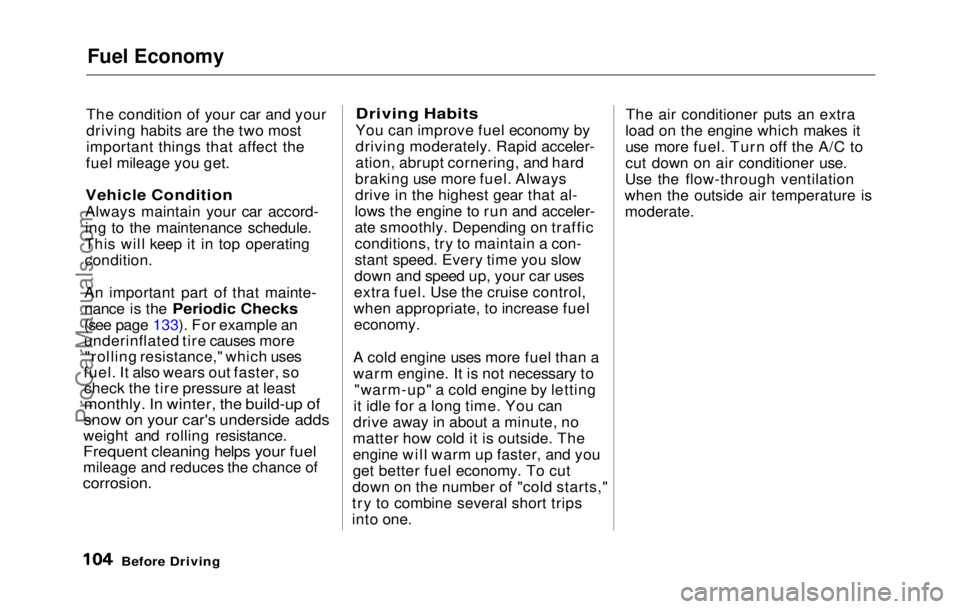
Fuel Economy
The condition of your car and your
driving habits are the two most
important things that affect the
fuel mileage you get.
Vehicle Condition
Always maintain your car accord-
ing to the maintenance schedule.
This will keep it in top operating
condition.
An important part of that mainte-
nance is the Periodic Checks
(see page
133). For example an
underinflated tire causes more "rolling resistance," which uses
fuel. It also wears out faster, so check the tire pressure at least
monthly. In winter, the build-up of
snow on your car's underside adds
weight and rolling resistance.
Frequent cleaning helps your fuel
mileage and reduces the chance of
corrosion.
Driving
Habit
s
You can improve fuel economy by
driving moderately. Rapid acceler-
ation, abrupt cornering, and hard
braking use more fuel. Always
drive in the highest gear that al-
lows the engine to run and acceler-
ate smoothly. Depending on traffic
conditions, try to maintain a con-
stant speed. Every time you slow
down and speed up, your car uses
extra fuel. Use the cruise control,
when appropriate, to increase fuel
economy.
A cold engine uses more fuel than a
warm engine. It is not necessary to "warm-up" a cold engine by letting
it idle for a long time. You can
drive away in about a minute, no
matter how cold it is outside. The
engine will warm up faster, and you
get better fuel economy. To cut
down on the number of "cold starts,"
try to combine several short trips
into one. The air conditioner puts an extra
load on the engine which makes it
use more fuel. Turn off the A/C to
cut down on air conditioner use.
Use the flow-through ventilation
when the outside air temperature is moderate.
Before DrivingProCarManuals.comMain Menu Table of Contents s t
Page 105 of 225
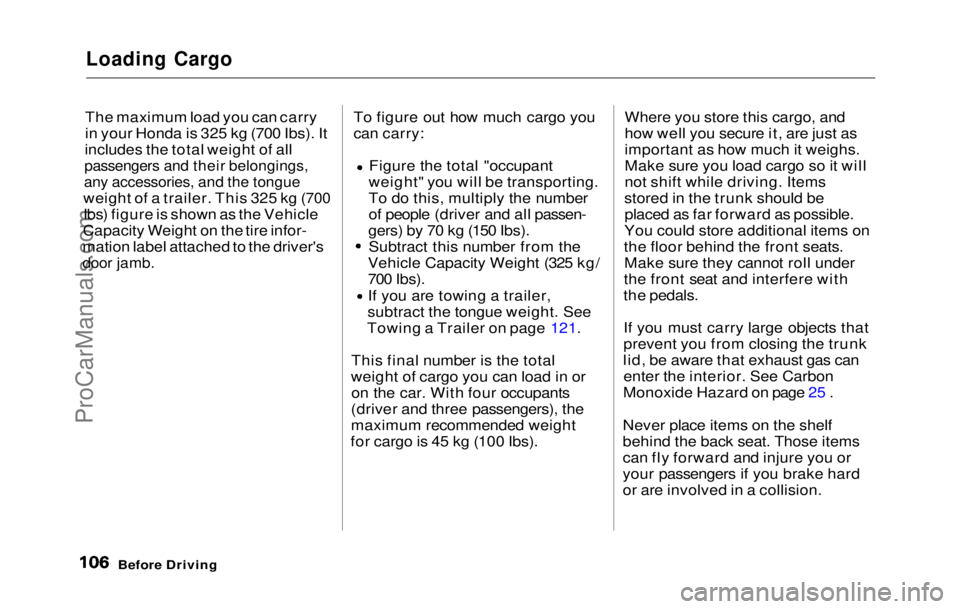
Loading Cargo
The maximum load you can carry
in your Honda is 325 kg (700 Ibs). It
includes the total weight of all
passengers and their belongings,
any accessories, and the tongue
weight of a trailer. This 325 kg (700
Ibs) figure
is shown as the Vehicle
Capacity Weight on the tire infor-
mation label attached to the driver's
door jamb.
To figure out how much cargo you
can carry:
Figure the total "occupant
weight" you will be transporting.
To do this, multiply the number
of people (driver and all passen-
gers) by 70 kg (150 Ibs). Subtract this number from the
Vehicle Capacity Weight (325 kg/
700 Ibs).
If you are towing a trailer,
subtract the tongue weight. See
Towing a Trailer on page 121.
This final number is the total
weight of cargo you can load in or on the car. With four occupants
(driver and three passengers), the
maximum recommended weight
for cargo is 45 kg (100 Ibs). Where you store this cargo, and
how well you secure it, are just as
important as how much it weighs.
Make sure you load cargo so it will
not shift while driving. Items
stored in the trunk should be placed as far forward as possible.
You could store additional items on
the floor behind the front seats. Make sure they cannot roll under
the front seat and interfere with
the pedals.
If you must carry large objects that
prevent you from closing the trunk
lid, be aware that exhaust gas can enter the interior. See Carbon
Monoxide Hazard on page 25 .
Never place items on the shelf
behind the back seat. Those items
can fly forward and injure you or
your passengers if you brake hard
or are involved in a collision.
Before DrivingProCarManuals.comMain Menu Table of Contents s t
Page 120 of 225
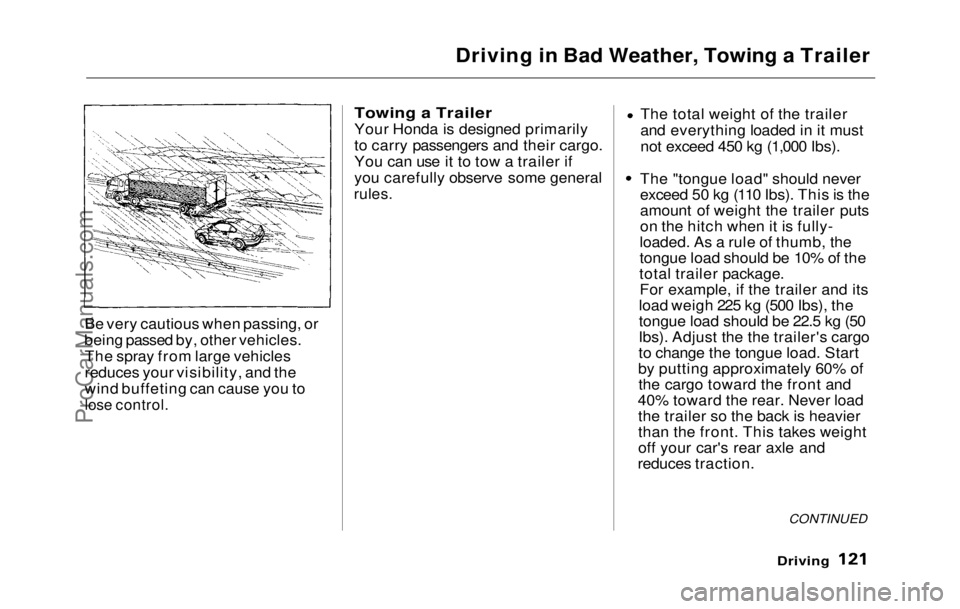
Driving in Bad Weather, Towing a Trailer
Be very cautious when passing, or
being passed by, other vehicles. The spray from large vehicles
reduces your visibility, and the
wind buffeting can cause you to
lose control.
Towing a Trailer
Your Honda is designed primarily
to carry passengers and their cargo.
You can use it to tow a trailer if
you carefully observe some general
rules.
The total weight of the trailer
and everything loaded in it must
not exceed 450 kg (1,000 Ibs). The "tongue load" should never
exceed 50 kg (110 Ibs). This is the
amount of weight the trailer puts
on the hitch when it is fully-
loaded. As a rule of thumb, the
tongue load should be 10% of the
total trailer package. For example, if the trailer and its
load weigh 225 kg (500 Ibs), the
tongue load should be 22.5 kg (50
Ibs). Adjust the the trailer's cargo
to change the tongue load. Start
by putting approximately 60% of the cargo toward the front and
40% toward the rear. Never load the trailer so the back is heavier
than the front. This takes weight
off your car's rear axle and
reduces traction.
CONTINUED
DrivingProCarManuals.comMain Menu Table of Contents s t
Page 121 of 225
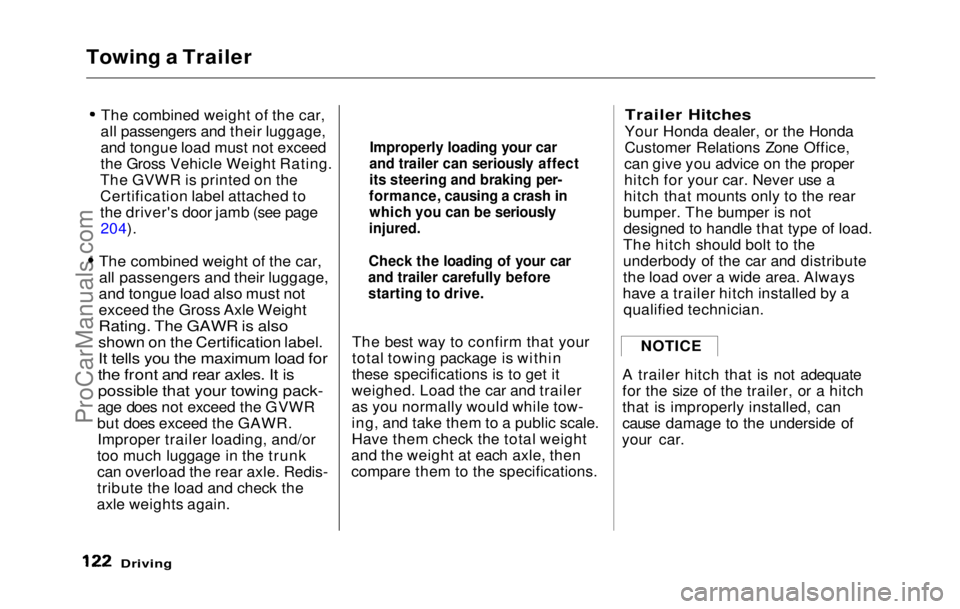
Towing a Trailer
The combined weight of the car,
all passengers and their luggage,
and tongue load must not exceed
the Gross Vehicle Weight Rating.
The GVWR is printed on the
Certification label attached to
the driver's door jamb (see page 204).
The combined weight of the car,
all passengers and their luggage,
and tongue load also must not
exceed the Gross Axle Weight
Rating. The GAWR is
also
shown on the Certification label.
It tell
s
you the maximum load for
the front and rear axles. It is
possible that your towing pack-
age does not exceed the GVWR
but does exceed the GAWR. Improper trailer loading, and/or
too much luggage in the trunk
can overload the rear axle. Redis-
tribute the load and check the
axle weights again. The best way to confirm that your
total towing package is within
these specifications is to get it
weighed. Load the car and trailer
as you normally would while tow-
ing, and take them to a public scale.
Have them check the total weight
and the weight at each axle, then
compare them to the specifications.
Trailer Hitches
Your Honda dealer, or the Honda
Customer Relations Zone Office,
can give you advice on the proper
hitch for your car. Never use a
hitch that mounts only to the rear
bumper. The bumper is not
designed to handle that type of load.
The hitch should bolt to the
underbody of the car and distribute
the load over a wide area. Always
have a trailer hitch installed by a qualified technician.
A trailer hitch that is not adequate
for the size of the trailer, or a hitch
that is improperly installed, can
cause damage to the underside of
your car.
Driving
Improperly loading your car
and trailer can seriously affect
its steering and braking per-
formance, causing a crash in which you can be seriously
injured.
Check the loading of your car
and trailer carefully before
starting to drive.
NOTICEProCarManuals.comMain Menu Table of Contents s t
Page 122 of 225

Towing a Trailer
Mirrors
Many states and provinces have
laws requiring special outsidemirrors when you are towing a
trailer. Check the laws in your area.
You may want to install mirrors, even if they are not required. Hook
up the trailer and see how much it obscures your ability to see behind
you with the standard mirrors. Ifyou cannot see directly behind you,
or have a large blind spot next to
the trailer or the car, you should
install mirrors intended for towing.
Connecting the Trailer
Most trailers that have a gross
weight of 450 kg (1,000 Ibs) do not
have their own braking system. If you are thinking of getting a trailer
that does have brakes, make sure
they are electrically-operated.
There are no provisions in your car
to tap into its hydraulic braking
system. Any attempt to attach the
trailer's brakes to your car's
hydraulic system, no matter how successful it may seem, will lower
braking effectiveness and create a potential hazard.
Always use a safety chain when towing a trailer. Connect the safety
chain securely at both ends. Make
sure the chain crosses under the
tongue so it will catch the trailer if
it becomes unhitched. Leave
enough slack in the chain so it can't
bind in a sharp turn. Do not let it drag on the ground.
Before Starting Out
As you are preparing to tow your
trailer, do the following:
Measure the trailer's tongue load.
You can do this with a bathroom
scale.
Verify that the hitch and safety chain are securely fastened.
Check the condition and air
pressure of all tires on the trailer
and your car. Low tire pressure
can seriously affect the handling.
Also check the spare tires.
With everything loaded and the
trailer connected, check that the
rear of the car is not sagging. If
so, redistribute the load in the
car.
Check that all lights on the car
are working properly.
DrivingProCarManuals.comMain Menu Table of Contents s t
Page 134 of 225
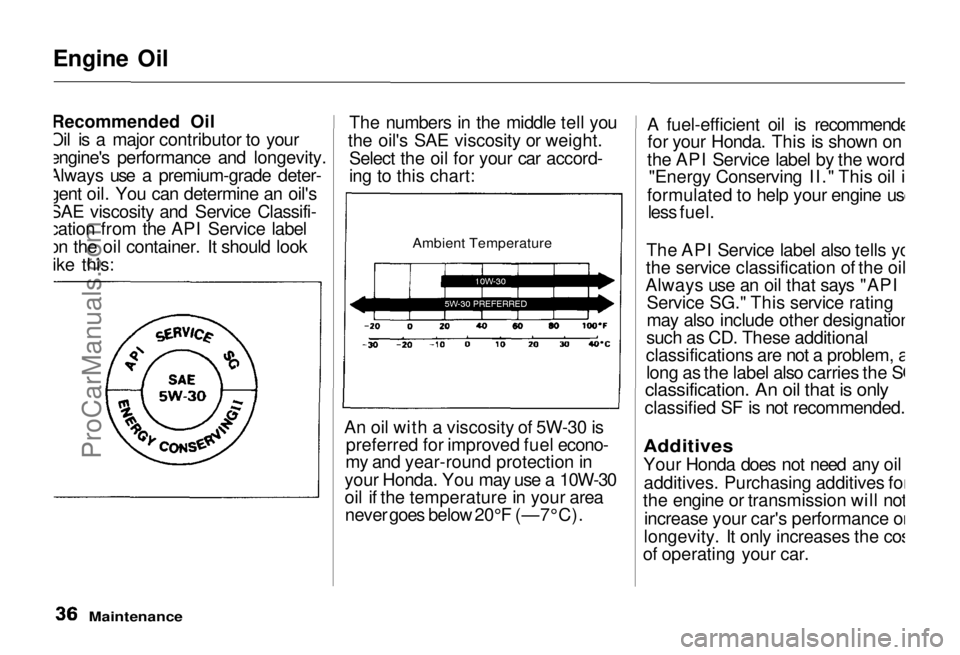
Engine Oil
Recommended Oil
Oil is a major contributor to your
engine's performance and longevity.
Always use a premium-grade deter-
gent oil. You can determine an oil's
SAE viscosity and Service Classifi-
cation from the API Service label
on the oil container. It should look
like this: The numbers in the middle tell you
the oil's SAE viscosity or weight. Select the oil for your car accord-
ing to this chart:
Ambient Temperature
An oil with a viscosity of 5W-30 is preferred for improved fuel econo-
my and year-round protection in
your Honda. You may use a 10W-30
oil if the temperature in your area never goes below 20°F (—7°C). A fuel-efficient oil is recommended
for your Honda. This is shown on
the API Service label by the words "Energy Conserving II." This oil is
formulated to help your engine use less fuel.
The API Service label also tells you
the service classification of the oil.
Always use an oil that says "API
Service SG." This service rating
may also include other designations,
such as CD. These additional
classifications are not a problem, as long as the label also carries the SG
classification. An oil that is only
classified SF is not recommended.
Additives
Your Honda does not need any oil additives. Purchasing additives for
the engine or transmission will not
increase your car's performance or
longevity. It only increases the cost
of operating your car.
MaintenanceProCarManuals.comMain Menu Table of Contents s t